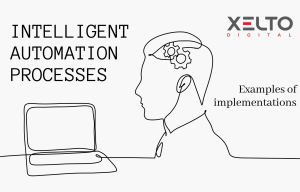The first season of the series about my adventures has just come to an end. So I would like to briefly sum up what happened in the last couple of months. If you followed my footsteps, you know perfectly well that I have turned from a regular robot into a fairly avant-garde Ed Robotowsky. I have been wearing a suit for a while now, my manners are impeccable, and I love to meet new people and join the teams of our Clients. At the end of the first season, I will tell you a secret. In the XELTO DIGITAL team, I am Ed, but, after automating the processes and joining the teams of Our Clients, I get a new name from my new Colleagues and embark on new, even more interesting adventures with each of the teams. If you are curious about the names I received so far, including female ones, follow the second season. In the meantime, let’s find out, for the last time in this season, about mine and Kamil’s opinion on the methods of process automation in the SAP ERP system.
With the Expert’s eye:
ERP systems are a regular feature in IT resources of large production companies that we meet in the context of automation of most processes. ERP systems follow business resources, such as cash, raw materials or production capacity, and the status of business liabilities, e.g. orders, purchasing and payroll. The applications comprising the system share these data to create an integrated and constantly updated view of the basic business processes with the use of shared databases kept by the database management system.
As a pioneer in creating such software, SAP was and still is the leader on the market. When implemented properly, the SAP ERP system is characterized with highly developed work culture and stability, which makes it a good basis for automation. Suffice it to say that the system itself is designed so as to enable the automation of some actions: it has a built-in register of macros which can be used also in our robots, but let me get back to this later.
NOTE: It needs to be remembered that to use all the blessings of automation, we need to first activate it at the server. This happens with the RZ10 transaction where we must edit the appropriate parameters.
An unquestionable benefit of automation of the SAP ERP system is a wide range of methods available for the purposes of automation. Robots created with the use of the UiPath may draw upon the whole database of universal actions which usually communicate with the SAP interface without any problems and create very stable and unambiguous selectors.
Apart from the default actions, the UiPath additionally prepared the suite of actions dedicated to SAP. These actions support the most frequent actions, such as system login, call for relevant transactions or readout of current message on the status bar, etc. They make the work on automation even more effective, and we do not have to spend time on programming all actions from scratch.
Another method I already mentioned is to record scripts with the use of macro register in SAP and to call them out with the code module. In this way, we can perform actions that cannot be performed at the time when we use the interface in a standard way (e.g. checking several columns in the table at once), or we can perform them more effectively. It may also be a kind of workaround when the basic actions do not fulfil their purpose, but this does not happen very often.
To sum up: the processes supported by the SAP ERP system are well suited for automation after meeting several other conditions. The way the application works with the UiPath and the stability of created solutions allow us to think that the processes automated in this way will cause no problems in use and will not require much maintenance outlay.
Author: Kamil Gawlista – RPA Developer
Foto: Freepik






